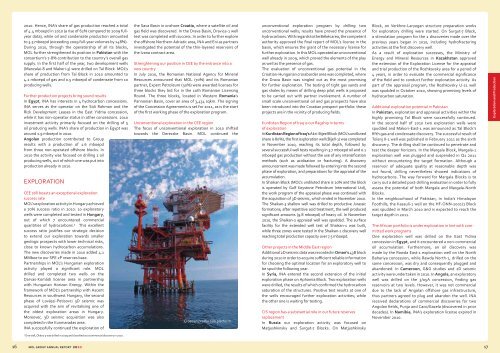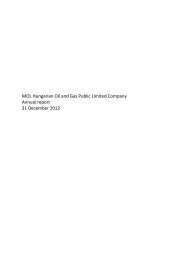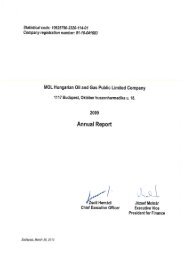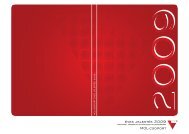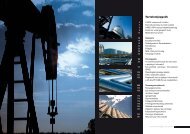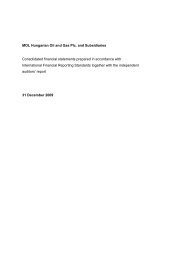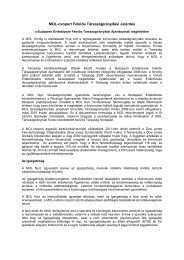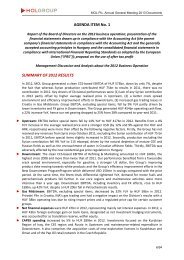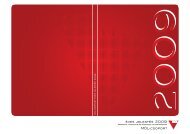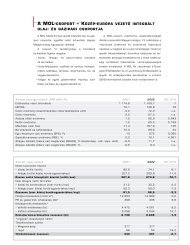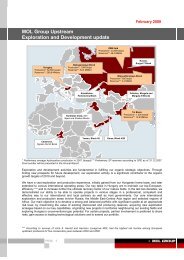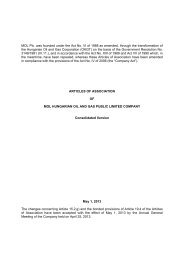MOL GROUP Annual Report
MOL GROUP Annual Report
MOL GROUP Annual Report
- No tags were found...
Create successful ePaper yourself
Turn your PDF publications into a flip-book with our unique Google optimized e-Paper software.
2010. Hence, INA’s share of gas production reached a totalof 4.4 mboepd in 2010 (a rise of 62% compared to 2009 fullyeardata), while oil and condensate production amountedto 3.5 mboepd (exceeding 2009 full-year volumes by 148%).During 2010, through the operatorship of all its blocks,<strong>MOL</strong> further strengthened its position in Pakistan with theconsortium’s 7-8% contribution to the country’s overall gassupply. In the first half of the year, two development wells(Manzalai-8 and Makori-3) were drilled on Tal Block. <strong>MOL</strong>’sshare of production from Tal Block in 2010 amounted to4.2 mboepd of gas and 0.5 mboepd of condensate from 10producing wells.Further production projects bring sound resultsIn Egypt, INA has interests in 4 hydrocarbon concessions.INA serves as the operator on the Sidi Rahman and theRizk Development Leases in the East Yidma concession,while it has non-operator status in other concessions. 2010investment activity primarily focused on the drilling of 5oil producing wells. INA’s share of production in Egypt wasaround 1.9 mboepd in 2010.Angolan production contributed to Groupresults with a production of 1.6 mboepdfrom three non-operated offshore blocks. In2010 the activity was focused on drilling 2 oilproducing wells, out of which one was put intoproduction already in 2010.EXPLORATIONCEE still boasts an exceptional explorationsuccess rate<strong>MOL</strong>’s exploration activity in Hungary achieveda 70% success ratio in 2010: 10 exploratorywells were completed and tested in Hungary,out of which 7 encountered commercialquantities of hydrocarbons. 1 This excellentsuccess ratio justifies our strategic decisionto extend our exploration towards smallergeologic prospects with lower technical risks,close to known hydrocarbon accumulations.The new discoveries made in 2010 added 4.1MMboe to our SPE 2P reserves base.Partnerships in <strong>MOL</strong>’s Hungarian explorationactivity played a significant role. <strong>MOL</strong>drilled and completed two wells on theDarvas-Komádi license area in partnershipwith Hungarian Horizon Energy. Within theframework of <strong>MOL</strong>’s partnership with AscentResources in southwest Hungary, the secondphase of Lovászi-Petisovci 3D seismic wasacquired with the aim of revitalising one ofthe oldest exploration areas in Hungary.Moreover, 3D seismic acquisition was alsocompleted in the Kunmaradas area.INA successfully continued the exploration ofthe Sava Basin in onshore Croatia, where a satellite oil andgas field was discovered. In the Drava Basin, Dravica-1 welltest was completed with success. In order to further explorethe offshore Northern Adriatic area, INA and Eni as partnersinvestigated the potential of the thin-layered reservoirs ofthe Ivana contract area.Strenghtening our position in CEE by the entrance into anew countryIn July 2010, the Romanian National Agency for MineralResources announced that <strong>MOL</strong> (70%) and its Romanianpartner, Expert Petroleum (30%) were awarded licenses forthree blocks they bid for in the 10th Romanian LicensingRound. The three blocks, located in Western Romania’sPannonian Basin, cover an area of 3,434 sqkm. The signingof the Concession Agreements is set for 2011, as is the startof the first working phase of the exploration program.Unconventional exploration in the CEE regionThe focus of unconventional exploration in 2010 shiftedtowards the Derecske Basin. <strong>MOL</strong> continued theCroatian production platformunconventional exploration program by drilling twounconventional wells; results have proved the presence ofhydrocarbons. With regards to the Békés area, the competentauthority approved the final report of <strong>MOL</strong>’s license in thebasin, which ensures the grant of the necessary license forfurther exploration. In this <strong>MOL</strong> operated an unconventionalwell already in 2009, which proved the elements of the playas well as the presence of gas.The evaluation of unconventional gas potential in theCroatian-Hungarian crossborder area was completed, wherethe Drava Basin was singled out as the most promisingfor further exploration. The testing of tight gas sands andgas shales by means of drilling deep pilot wells is proposedto be carried out with partner involvement. A number ofsmall scale unconventional oil and gas prospects have alsobeen introduced into the Croatian prospect portfolio: theseprojects are in the vicinity of producing fields.Kurdistan Region of Iraq is our flagship in termsof explorationIn Kurdistan Region of Iraq’s Akri-Bijeel Block (<strong>MOL</strong>’s undilutedshare is 80%), the first exploration well (Bijell-1) was completedin November 2010, reaching its total depth, followed byseveral successful well tests resulting in 3.7 mboepd oil and 0.1mboepd gas production without the use of any intensificationmethods (such as acidisation or fracturing). A discoveryannouncement was made followed by entering into the secondphase of exploration, and preparations for the appraisal of theaccumulation.In Shaikan Block (<strong>MOL</strong>’s undiluted share is 20% and the blockis operated by Gulf Keystone Petroleum International Ltd),the work program of the appraisal phase was continued withthe acquisition of 3D seismic, which ended in November 2010.The Shaikan-3 shallow well was drilled to productive Jurassicformations; after repetitive acid treatment, the well producedsignificant amounts (9.8 mboepd) of heavy oil. In November2010, the Shaikan-2 appraisal well was spudded. The surfacefacility for the extended well test of Shaikan-1 was built,while three zones were tested in the Shaikan-1 discovery wellreaching total production capacity over 7.5 mboepd.Other projects in the Middle East regionAdditional 2D seismic data was recorded in Oman’s 43B blockduring 2010 in order to acquire sufficient reliable informationfor choosing the optimal location for an exploratory well tobe spud the following year.In Syria, INA entered the second extension of the initialexploration phase on Aphamia Block. Two exploration wellswere drilled, the results of which confirmed the hydrocarbonsaturation of the structures. Positive test results at one ofthe wells encouraged further exploration activities; whilethe other one is waiting for testing.CIS region has a substantial role in our future reservesreplacementIn Russia our exploration activity was focused onMatjushkinsky and Surgut-7 Blocks. On MatjushkinskyBlock, on Verkhne-Laryegan structure preparation worksfor exploratory drilling were started. On Surgut-7 Block,a stimulation program for the 2 discoveries made over theprevious years began in 2010, including hydrofracturingactivities at the first discovery well.As a result of exploration successes, the Ministry ofEnergy and Mineral Resources in Kazakhstan approvedthe extension of the Exploration License for the appraisaland trial production of the Rozhkovsky area for a period of4 years, in order to evaluate the commercial significanceof the field and to conduct further exploration activity. Aspart of the appraisal program, the Rozhkovsky U-21 wellwas spudded in October 2010, showing promising levels ofhydrocarbon saturation.Additional exploration potential in PakistanIn Pakistan, exploration and appraisal activities within thehighly promising Tal Block were successfully continued.In the second half of 2010 two exploration wells werespudded and Makori-East-1 was announced as Tal Block’sfifth gas and condensate discovery. The successful result ofTolanj X-1 well was published in February 2011 as the sixthdiscovery. The drilling shall be continued to penetrate andtest the deeper horizons. In the Margala Block, Margala-1exploration well was plugged and suspended in Q1 2011without encountering the target formation. Although areservoir of adequate quality at reasonable depth wasnot found, drilling nevertheless showed indications ofhydrocarbons. The way forward for Margala Blocks is tocarry out a detailed post-drilling evaluation in order to fullyassess the potential of both Margala and Margala-NorthBlocks.In the neighbourhood of Pakistan, in India’s HimalayanFoothills, the Kasauli-1 well on the HF-ONN-2001/1 Blockwas spudded in March 2010 and is expected to reach thetarget depth in 2011.The African portfolio is under exploration in line with committedwork programsOne exploration well was drilled on the East Yidmaconcession in Egypt, and it encountered a non-commercialoil accumulation. Furthermore, an oil discovery wasmade by the Rawda East-1 exploration well on the NorthBahariya concession, while Rawda North-1, drilled on thesame concession, was dry and consequently plugged andabandoned. In Cameroon, G&G studies and 2D seismicactivity were undertaken in 2010. In Angola, an exploratorywell was drilled on the 3/05A concession, finding gasreservoirs at two levels. However, it was not commercialdue to the lack of Angolan offshore gas infrastructure,thus partners agreed to plug and abandon the well. INAreceived declarations of commercial discoveries for twoAngolan fields, Punja and Caco/Gazela (discovered in priordecades). In Namibia, INA’s exploration license expired inNovember 2010.Exploration and Production1One well, Okány-3 was drilled in 2009 and classified as a commercial discovery in 2010.16 <strong>MOL</strong> Group annual report 2010 17


